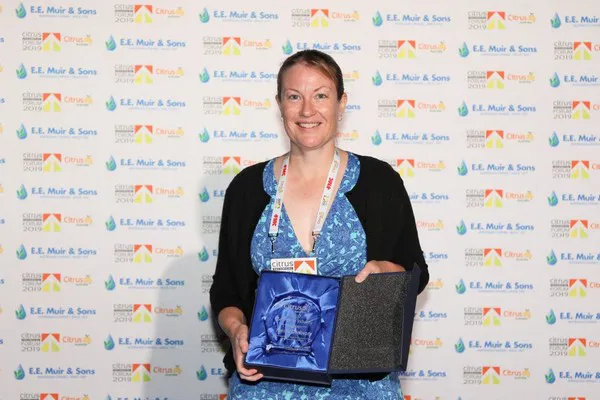Citrus Australia published an interview with Dr Nerida Donovan, who received the Service to Industry award at the 2019 Citrus Australia Tech Forum.
Learning how other countries manage HLB will help shape Australia’s response if the damaging citrus disease hits our shores, according to NSW Citrus Pathologist, Dr Nerida Donovan.
And one of the biggest lessons so far has been the importance of treating the psyllid vector with the same “respect” as the disease.
Dr Donovan, NSW Department of Primary Industries, is part of a team working to strengthen the Australian citrus industry’s biosecurity with a project focusing on graft-transmissible diseases funded by Hort Innovation.
“The program is designed to enhance the preparedness of industry and government to combat citrus disease threats,” she said.

“To be able to do that, we have developed the capability to test for citrus diseases that we have in the country and exotic diseases that are not found here yet. (The graft transmissible pathogens) are in the vascular tissue of the plants and there is no cure for them. You either prevent them or you live with them. Some diseases lead to reduced yield or they can kill your trees.”
The project works closely with the Auscitrus propagation scheme to ensure industry has access to high health status propagation material by testing their budwood and rootstock seed source trees for disease and by maintaining foundation trees (of the highest health status) in the National Citrus Repository Program, Dr Donovan said.
Huanglongbing (HLB) preparedness is a priority of this project– looking at different detection methods, expanding the diagnostic capability to other labs in Australia and participating in surveillance programs.
A Citrus Australia Citrus Pest and Disease Prevention Committee member, Dr Donovan is part of that team looking at other ways to improve HLB preparedness, as well as preparedness for other disease and pest threats which she said would be dangerous to ignore.
A focus of the HLB preparedness has been building awareness of field systems and what the vector looks like, according to Dr Donovan.
International collaboration and field work have better equipped scientists with these identification skills, but Dr Donovan said one of the challenges for the Australian industry comes from outside citrus.
“It is particularly concerning that Murraya is a preferred host of the psyllid, it is a plant you see across most Australian towns and cities, in hedges in schools, businesses and homes,” she said.
“This means the nursery industry has to be equally invested in eradication for it to be successful.”
Dr Donovan said there were many factors which determined Australia’s ability to deal with HLB.
“It would depend on where it is found, the magnitude of the spread, and how early we detect it as to how we respond and even if we are able to respond and eradicate,” she said.
For the full interview, please click here.
